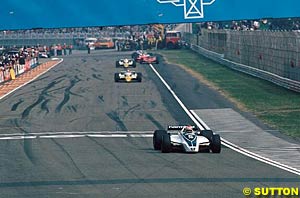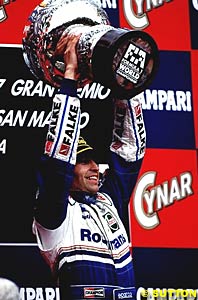
Atlas F1 Magazine Writer
When was the last time we had two new Grand Prix winners in the first three races of the season? Which car was used the most number of seasons? And what happened at Imola in 1980, when the place hosted its only Italian Grand Prix? Marcel Schot brings the answers and more anecdotes on the fourth Grand Prix of the 2003 season
In 1989, the Benetton team wasn't able to get the new B189 ready for the start of the season. This provided the team with two problems: first, they obviously had to use the old B188 chassis. More importantly, as their new Ford HB engine didn't fit in the old design, they were also limited to the Cosworth DFR engine that the smaller teams were using.
The new chassis suffered continuous problems, mainly with the suspension and engine vibrations. The first B189 was finally ready for the French Grand Prix, which was the seventh race of the season. However, it was not until the British Grand Prix two weeks later that both drivers had the use of the new car. It didn't help much, though; a third position in the Constructors' Championship after six races turned into a fourth position by the end of the season.
So far the F2002 is not performing as well as it had last year. In the past 30 years, 100 cars were used beyond their debut year. Only 13 of those won one or more races. McLaren's M23 is the clear king of re-usability. The car lasted four seasons, used in a massive 148 Grands Prix and won 13 more races after its debut season. However, when it comes to lasting power, Ferrari can think of their 312T with pride.
After a rocky start of the 1975 season in the old 312B3, the 312T made its debut in the third race of the season. Six races were won, as well as both the Drivers' and Consuctors' Championships. In 1976, the team drove the first three races with the old car and won all three of them. The final race of the 312T even ended in a one-two for the Maranello team.
Of those 47 wins in older cars, one came at Imola. In 1980 there was no San Marino Grand Prix, but after a lot of political hastling Imola was to host the Italian Grand Prix.
Just like in the previous two races, the Renaults were the crop of the class in qualifying. On Friday afternoon Jean-Pierre Jabouille was the fastest by far, driving four tenths quicker than teammate Rene Arnoux. Bruno Giacomelli in the Alfa was the surprising number three, little over seven tenths back. Alan Jones (Williams), Nelson Piquet and Jones' teammate Carlos Reutemann followed within a tenth of the Alfa driver, behind whom there was a gap of a full second to Gilles Villeneuve in the first Ferrari.
On Saturday Jabouille wasn't able to improve his time, but Arnoux was. The Frenchman put the number 16 Renault on Pole almost half a second faster than his teammate. Carlos Reutemann claimed third on the grid, just ahead of Giacomelli, Piquet and Jones.
This year, Jarno Trulli and Fernando Alonso may have high hopes for the San Marino Grand Prix: it's always been a warm home to Renault engined cars, and in fact seven of the 20 San Marino Grands Prix have been won by cars with a Renault engine. Elio de Angelis was the first one with the Lotus-Renault in 1985. He was followed by Riccardo Patrese, who won for Williams in 1990. Five more Williams-Renault victories followed in the next seven years. Damon Hill was the only one to do it twice, while Nigel Mansell, Alain Prost and Heinz-Harald Frentzen all contributed to Renault's success at the Autodromo Enzo e Dino Ferrari.
For Frentzen, the 1997 San Marino Grand Prix was a special victory, since it was his first. In qualifying Williams was dominant, with Jacques Villeneuve claiming pole and Frentzen completing the front row. However, Frentzen got a slight scare when confronted with a steward's report. The German had failed to sufficiently slow down at a yellow flag situation. Luckily for Frentzen it didn't have any influence on his starting position, but he was sentenced to a suspended race ban.
At the start, Frentzen had to see Michael Schumacher's Ferrari blow past him, but good pitstop tactics put him in the lead after the first round of stops. When Frentzen stopped for the second time, Schumacher briefly took the lead. When the Ferrari driver pitted the next lap, the road was free for Frentzen's first win. However, the lead was never big and Schumacher came closer and closer in the final stages of the race. In the end, the gap was a little over one second.
With Giancarlo Fisichella getting his first win in Brazil last weekend and Kimi Raikkonen clinching his maiden victory two weeks before, in Malaysia, we now have two new Grand Prix winners in the first three races of the season. This hasn't happened since 1967, when Pedro Rodriguez won at Kyalami and Denny Hulme won the Monaco Grand Prix to open the season. Hulme would continue the season in impressive style to win the World Championship.
 While Ferrari earlier announced the F2003GA would make its debut during the next Grand Prix at Imola, the first raceappearance of the new car has been delayed until the Spanish Grand Prix. To see a design used in the previous season being used as late as the fourth race of its second season, we must go back quite a long time.
While Ferrari earlier announced the F2003GA would make its debut during the next Grand Prix at Imola, the first raceappearance of the new car has been delayed until the Spanish Grand Prix. To see a design used in the previous season being used as late as the fourth race of its second season, we must go back quite a long time.
Car Debut End Wins Participations
after debut year
=============== ===== ===== ===== ================
McLaren M23 1973 1976 13 148
Tyrrell 006 1972 1973 5 33
Ferrari 312T2 1976 1978 5 38
McLaren M26 1977 1978 3 68
Lotus 72E 1973 1974 3 53
Ferrari 312T 1975 1976 3 6
Ferrari 312B3 1973 1974 3 34
Brabham BT49 1979 1980 3 28
Tyrrell 011 1981 1983 2 56
Lotus 78 1977 1978 2 28
Williams FW07 1979 1980 1 11
Williams FW09 1983 1984 1 18
Tyrrell 007 1974 1975 1 48
Shadow DN8 1976 1977 1 45
Ferrari F2001 2001 2002 1 5
 In a race that's most well known for Gilles Villeneuve's horrific crash on the fifth lap, the Renaults couldn't quite match their qualifying pace and after good starts of both Brabham drivers, Nelson Piquet took the lead after four laps and never looked back. Only the Williamses could remotely follow the Brazilian. At the end of the race, Piquet was nearly 30 seconds clear of Alan Jones, while Carlos Reutemann was the only other unlapped car, at one minute and 13 seconds behind the winner.
In a race that's most well known for Gilles Villeneuve's horrific crash on the fifth lap, the Renaults couldn't quite match their qualifying pace and after good starts of both Brabham drivers, Nelson Piquet took the lead after four laps and never looked back. Only the Williamses could remotely follow the Brazilian. At the end of the race, Piquet was nearly 30 seconds clear of Alan Jones, while Carlos Reutemann was the only other unlapped car, at one minute and 13 seconds behind the winner.
|
Volume 9, Issue 16
Atlas F1 Exclusive
Giancarlo Fisichella: Through the Visor
Interview with Patrick Head
Interview with Nick Heidfeld
San Marino GP Preview
2003 San Marino GP Preview
San Marino Facts & Stats
Columns
The Fuel Stop
The F1 Trivia Quiz
Bookworm Critique
On the Road
Elsewhere in Racing
The Weekly Grapevine
> Homepage |